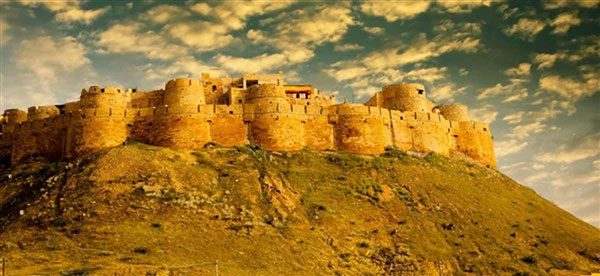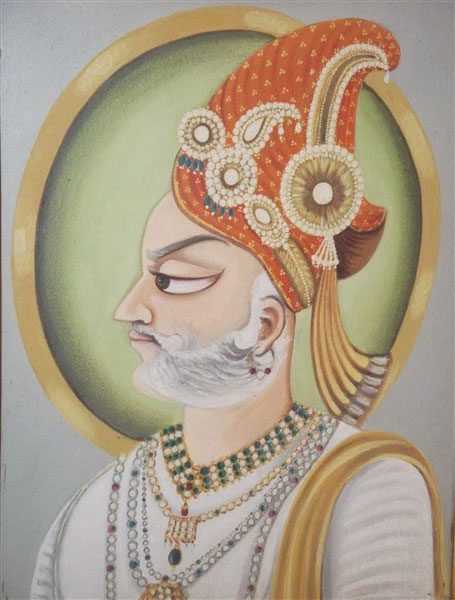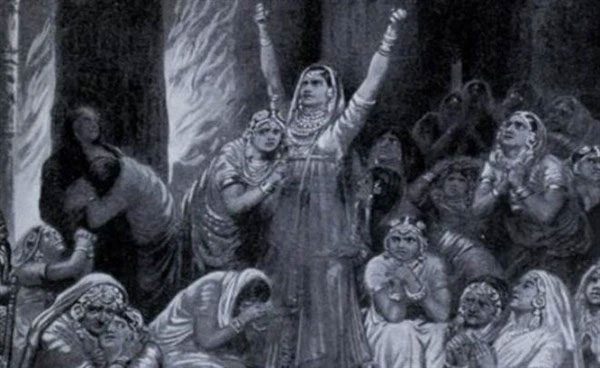Deep within the Thar Desert (India), a dazzling yellow fort stands tall. Built in the 12th century, it is known as a “living fort” because it remains sturdy and inhabited. This fort is called Jaisalmer in India.
Surrounding Jaisalmer is the bustling city of the same name. It makes one almost forget that this place was once the site of horrific collective killings and cremations of thousands of women under the most dreadful wartime tradition of the feudal era: Jauhar.

“The Living Fort” of dazzling yellow – Jaisalmer, Rajasthan, India.
The Trade Fort
Jaisalmer is located atop Trikuta Hill, in the heart of the Thar Desert in Rajasthan. According to Indian history, it was commissioned by the royal family of Rawal Jaisal (1153 – 1168) in 1156.
While surveying the Trikuta terrain, Jaisal discovered a massive triangular rock formation rising 75 meters above the surrounding land. Satisfied with this find, he decided it would be the site for a new palace and built fortifications for protection.
The Jaisalmer Fort emerged, encompassing the rocky hill with dimensions of 460 x 230 meters. The outermost wall stands 4.6 meters high, with a perimeter of 4 kilometers, featuring 4 gates and 99 watchtowers. Constructed from yellow sandstone, it is magnificent and robust. The locals refer to it as Sonar Quila, meaning “Golden Fort.”
Inside Jaisalmer, a variety of monumental architectural structures can be found, including palaces, temples, squares, and residences, sufficient to house thousands of inhabitants.
Geographically, Jaisalmer lies at the crossroads of ancient and medieval Indian trade routes, including the Silk Road. Merchant caravans were required to pass through it, and the royal family of Rawal levied high taxes on traders, fostering commerce and exchange. They soon became wealthy, transforming Jaisalmer into one of the most prosperous forts.
A Horrific History

King Rawal Jaisal (1153 – 1168), the first ruler of Jaisalmer.
In 1285, Jaisalmer was attacked by King Alauddin Khalji (1266 – 1316) of the Khalji dynasty (based in Delhi, India). Thanks to its formidable fortifications, Rawal Jethsi (a descendant of Jaisal) easily defended the fort.
After failing to conquer the fort, Khalji changed tactics and laid siege, refusing to withdraw. After 8 to 9 years of being cut off, Jaisalmer ran out of resources. Rather than surrender, Rawal Jethsi ordered the execution of the Jauhar law.
Jauhar is the most terrifying honor-based execution tradition in India. It dates back to before the Common Era and is practiced in situations of impending defeat. Men facing defeat would kill all the women, regardless of age, and prepare a pyre for collective cremation. Afterward, they would charge into battle, dying at the hands of the enemy.
The roots of Jauhar lie in extreme patriarchal Hindu culture and the brutality of war. Women in feudal India had no human rights and were considered property of their fathers, husbands, brothers, or sons. If captured by enemies, they faced a fate of enslavement and sexual servitude. Hindu men chose to execute them beforehand, denying the enemy the chance to humiliate them.
Upon Jethsi’s command, all women in Jaisalmer were killed and cremated in the fort square. Male warriors of Jaisalmer opened the gates and charged out to fight to the death. In the aftermath, Jaisalmer was left abandoned. Many years later, survivors returned to rekindle life.
From 1530 to 1551, Jaisalmer faced the threat of conquest once again. This time, it was attacked and besieged by Afghan forces. Fearing defeat, King Rawal Lunakaran ordered Jauhar to be enacted. He and his warriors slaughtered their wives, daughters, and sisters… However, just after they carried out the act, reinforcements arrived, and Jaisalmer successfully repelled the invaders.
Each time Jauhar was enacted, thousands of women living in Jaisalmer were slaughtered and cremated. Its square was drenched in blood and fire for months. At least, Jaisalmer witnessed Jauhar three times.
A Living Heritage

Jaisalmer has undergone Jauhar multiple times, killing and cremating all women within the fort.
In the 19th century, India was under British colonial rule. The British colonizers focused on developing maritime trade and building the port of Bombay, causing Jaisalmer to gradually fade into obscurity.
In 1947, India gained independence. The ancient and medieval trade routes passing through Jaisalmer were closed, isolating the fort from its crucial trade role. However, Jaisalmer’s economy managed to escape the threat of decline.
In 2013, this ancient fort was recognized as a UNESCO World Heritage site. Besides the title of “the oldest desert fort in the world,” it is also renowned as a “living fort,” as it remains intact and inhabited.
Currently, Jaisalmer is home to about 4,000 people, descendants of the medieval residents who lived within the fort.
Despite 800 years passing, the grandeur of Jaisalmer remains as magnificent as ever. By day, it basks in the bright sunshine of the desert, glowing yellow like a lion’s mane. At dusk, it catches the sunset, transforming into a dark golden color like honey.
The biggest concern for Jaisalmer now is… water. Since entering the modern era, residents within the fort have been competing to install water pipes for their daily needs. The ancient fort in the desert, unaccustomed to water intrusion, is gradually falling into disrepair.
In recent years, due to tourism growth, Jaisalmer demands more water. This has led to increased wastewater, damaging the foundation and structure. Despite efforts to cope, heritage conservationists in Jaisalmer can only slow down the deterioration process. To protect the “Golden Fort,” India must establish a scientifically advanced and extremely costly drainage system.





















































